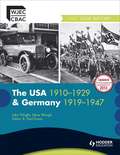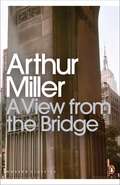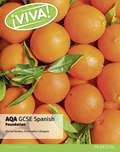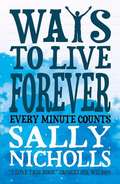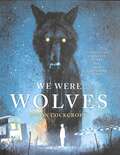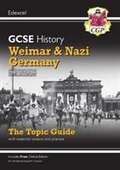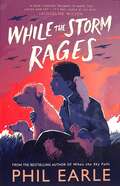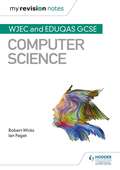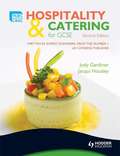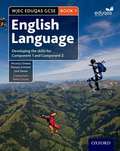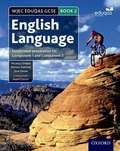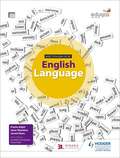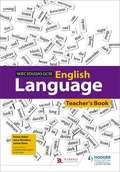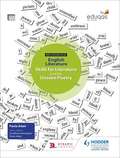- Table View
- List View
The USA 1910-1929 and Germany 1929-1947 (PDF)
by Steve Waugh Paul Evans John WrightWritten by experts and endorsed by WJEC, this series gives students in-depth topic-focused content and structured support with exam skills for WJEC GCSE History. This series for WJEC GCSE History has been written to encourage students to achieve their best. It does this by combining detailed narrative and a rich variety of sources with a highly structured approach to gradually developing students' skills in answering exam-style questions as they work through the course. Allows students to gain a good knowledge and understanding of the content by outlining and examining the key issues of the GCSE history topic in turn. Develops students enthusiasm for learning the topic through a variety of activities designed to engage and motivate them. Helps students feel secure in how they will be assessed by providing dedicated support in how to answer different exam-style questions, including exam-model answers, exam tips and commentary.nbsp;
Vectors (large print)
by Rnib BookshareThis page shows two forces (measured in Newtons) acting upon an object represented by a square and their vector sum. There is a locator dot shown, which will be at the top left of the page when the image is the right way up. Towards the top left of the page the square is shown with an arrow to its left and pointing right, that indicates a force of 3 Newtons acting on it. Down the page, is an upward-pointing arrow indicating a force of 5 Newtons acting on the object. Across the lower half of the page, the forces acting on the object, and their vector sum, are shown in three steps, each labelled across the bottom of the page: Step 1. Represents a force of 5 Newtons, it shows a vertical line with an arrowhead at the top showing its direction. There is a scale marked by six short horizontal lines to its left. Step 2. Represents a force of 3 Newtons, it shows the line as in step 1 and additionally a right-pointing arrow with a scale of four short vertical lines up the page.Step 3. Is the same as step 2 with an additional arrow-headed line pointing up and right diagonally, representing the vector sum of the 5 and 3 Newton forces. Further to right, there is a leader line pointing to an explanatory label.
Vectors (UEB contracted)
by Rnib BookshareThis page shows two forces (measured in Newtons) acting upon an object represented by a square and their vector sum. There is a locator dot shown, which will be at the top left of the page when the image is the right way up. Towards the top left of the page the square is shown with an arrow to its left and pointing right, that indicates a force of 3 Newtons acting on it. Down the page, is an upward-pointing arrow indicating a force of 5 Newtons acting on the object. Across the lower half of the page, the forces acting on the object, and their vector sum, are shown in three steps, each labelled across the bottom of the page: Step 1. Represents a force of 5 Newtons, it shows a vertical line with an arrowhead at the top showing its direction. There is a scale marked by six short horizontal lines to its left. Step 2. Represents a force of 3 Newtons, it shows the line as in step 1 and additionally a right-pointing arrow with a scale of four short vertical lines up the page.Step 3. Is the same as step 2 with an additional arrow-headed line pointing up and right diagonally, representing the vector sum of the 5 and 3 Newton forces. Further to right, there is a leader line pointing to an explanatory label.
Vectors (UEB uncontracted)
by Rnib BookshareThis page shows two forces (measured in Newtons) acting upon an object represented by a square and their vector sum. There is a locator dot shown, which will be at the top left of the page when the image is the right way up. Towards the top left of the page the square is shown with an arrow to its left and pointing right, that indicates a force of 3 Newtons acting on it. Down the page, is an upward-pointing arrow indicating a force of 5 Newtons acting on the object. Across the lower half of the page, the forces acting on the object, and their vector sum, are shown in three steps, each labelled across the bottom of the page: Step 1. Represents a force of 5 Newtons, it shows a vertical line with an arrowhead at the top showing its direction. There is a scale marked by six short horizontal lines to its left. Step 2. Represents a force of 3 Newtons, it shows the line as in step 1 and additionally a right-pointing arrow with a scale of four short vertical lines up the page.Step 3. Is the same as step 2 with an additional arrow-headed line pointing up and right diagonally, representing the vector sum of the 5 and 3 Newton forces. Further to right, there is a leader line pointing to an explanatory label.
Velocity-time graph
On this page there is a graph showing velocity plotted against time. There is a locator dot shown, which will be at the top left of the page when the image is the right way up. The y-axis (velocity) is a line that extends vertically down the left-hand side of the page. Three-quarters of the way down the page, it meets the line of the x-axis (time) at a point marked with a zero (the origin). The x-axis extends horizontally across the page. A thick dashed line, which starts at the origin and goes up and down the page to the right, indicates various stages of velocity against time. Leader lines point from the plotted line to labels indicating these stages of travel.
Velocity-time graph
On this page there is a graph showing velocity plotted against time. There is a locator dot shown, which will be at the top left of the page when the image is the right way up. The y-axis (velocity) is a line that extends vertically down the left-hand side of the page. Three-quarters of the way down the page, it meets the line of the x-axis (time) at a point marked with a zero (the origin). The x-axis extends horizontally across the page. A thick dashed line, which starts at the origin and goes up and down the page to the right, indicates various stages of velocity against time. Leader lines point from the plotted line to labels indicating these stages of travel.
Velocity-time graph
On this page there is a graph showing velocity plotted against time. There is a locator dot shown, which will be at the top left of the page when the image is the right way up. The y-axis (velocity) is a line that extends vertically down the left-hand side of the page. Three-quarters of the way down the page, it meets the line of the x-axis (time) at a point marked with a zero (the origin). The x-axis extends horizontally across the page. A thick dashed line, which starts at the origin and goes up and down the page to the right, indicates various stages of velocity against time. Leader lines point from the plotted line to labels indicating these stages of travel.
A View from the Bridge (PDF)
by Arthur MillerFor Eddie, it's a privilege to take in his wife's cousins, straight off the boat from Italy. But, as his niece begins to fall for one of them, it's clear that it's not just, as Eddie claims, that he's too strange, too sissy, too careless for her, but that something bigger, deeper is wrong, and wrong inside Eddie, in a way he can't face. Something which threatens the happiness of their whole family.
A View from the Bridge (PDF)
by Arthur MillerFor Eddie, it's a privilege to take in his wife's cousins, straight off the boat from Italy. But, as his niece begins to fall for one of them, it's clear that it's not just, as Eddie claims, that he's too strange, too sissy, too careless for her, but that something bigger, deeper is wrong, and wrong inside Eddie, in a way he can't face. Something which threatens the happiness of their whole family.
Viva!: AQA GCSE Spanish, Foundation student book (PDF)
by Christopher Lillington Rachel HawkesExpertly structured Student Book for AQA GCSE 2016 Spanish (foundation tier). Designed to help learners use language independently and to the best of their ability, with fresh and engaging content from the target language culture. Designed for the new AQA GCSE Spanish qualification (foundation tier). A carefully designed programme of learning teaches the 'building blocks' of Spanish grammar and vocabulary. Includes popular topics, authentic material and real life-contexts; all with links to the Spanish culture. Each unit and module is structured to allow gradual progression. Exam preparation units are included for Reading, Writing, Speaking and Listening. Revision forms the final module.
Ways To Live Forever
by Sally NichollsMy name is Sam. I am eleven years old. I collect stories and fantastic facts. By the time you read this, I will probably be dead. Sam loves facts. He wants to know about UFOs and horror movies and airships and ghosts and scientists, and how it feels to kiss a girl. And because he has leukaemia he wants to know the facts about dying. Sam needs answers to the questions nobody will answer. WAYS TO LIVE FOREVER is the first novel from an extraordinarily talented young writer. Funny and honest, it is one of the most powerful and uplifting books you will ever read.
We Were Wolves
by Jason CockcroftAn intense, darkly spellbinding story of a boy awaiting his father's return from prison as an ancient woodland awakes
Weimar And Nazi Germany, 1918-39
by Cgp Books"CGP's indispensable Topic Guide for Edexcel 9-1 GCSE History - Weimar and Nazi Germany (1918-39) has everything students need for exam success. It's packed with crystal-clear revision notes, heaps of activities, sources, interpretations and exam-style questions (with answers) - for students to test their understanding of the topic and the skills they'll need for the exam. Our handy worked answers and advice mean students can walk into the exam feeling confident they know what good answers look like. Plus there are exam tips throughout the book.
While The Storm Rages
by Phil EarleNoah and his friends fight to save animals from being put to sleep at the outbreak of World War Two.
Wideworld Volume 31 Issue 1 (PDF)
by Jane Ferretti Brian Greasley Malcolm RenwickGCSE Geography magazine
Wideworld Volume 31 Issue 2 (PDF)
by Jane Ferretti Brian Greasley Malcolm RenwickGCSE Geography magazine
Wideworld Volume 31 Issue 3 (PDF)
by Jane Ferretti Brian Greasley Malcolm RenwickGCSE Geography magazine
Wideworld Volume 31 Issue 4 (PDF)
by Jane Ferretti Brian Greasley Malcolm RenwickGCSE Geography magazine
WJEC and Eduqas GCSE Computer Science - My Revision Notes (PDF)
by Rhys Richardson Robert WicksExam board: WJEC Level: GCSE Subject: Computer Science First teaching: September 2017 First exams: Summer 2019 Strengthen your students' understanding and upgrade their confidence with My Revision Notes: WJEC Eduqas GCSE (9-1) Computer Science. Written by leading Computer Science experts this is the only revision guide aimed specifically at helping students prepare for the WJEC or Eduqas exam - a new title in the top-selling revision guide series, loved by students and recommended by teachers. · Let students take control of their revision - plan and focus on the areas where they need to improve their knowledge and understanding with advice and summaries from the experts. · Help them achieve their potential - exam tips on computer science terms and concepts highlighted throughout the book · Improve their exam skills - a range of exam practice questions and 'test yourself questions' with answers at the back of the book.
WJEC/CBAC Hospitality and Catering for GCSE
by Gardiner Judy|Housley, JacquiCompletely revised and updated for WJEC's new courses in GCSE Hospitality and Catering, this book is designed to support students throughout their study, coursework preparation and revision for final exams. The book is packed with all the information that students will need for the course and has been expanded to provide more knowledge in some key areas.nbsp;All the information is presented in a colourful, uncomplicated and concise fashion. It is illustrated with photos and cartoons throughout, bringing the subject alive, as well as hands-on activities and revision questions to ensure your students are suitably prepared for the course. Additional information on topics including job roles, customer care, environmental issues and healthy eating guidelines. Assessment advice that reflects the new specifications. Exemplar exam questions and answers with exam advice written by experienced examiners who understand exactly what students need to succeed. The first book available for GCSE Hospitality and Catering (Single and Double Award). An ideal resource to support BTEC First in Hospitality and the new Diploma in Hospitality.
WJEC Eduqas GCSE English Language: Book 1 (PDF)
by Michelle DoranStudent Book 1 develops the key reading and writing skills that students will be assessed on in Component 1 and Component 2 of the WJEC GCSE English Language qualification. Structured around the Assessment Objectives, the book engages students through a thematic approach with inspiring texts that helps prepare students for the thematic connections they will face in the examinations. Through a range of texts, activities, stretch and support features as well as tipsand key terms, this book helps students of all abilities develop their reading and writing skills. Spelling, punctuation and grammar activities and guidance are provided in context to help improve students' technical accuracy. In addition to the regular peer and self-assessment activities, teachers canmonitor progress through the substantive end-of-chapter assessments and the sample exam papers.
WJEC Eduqas GCSE English Language: Assessment preparation for Component 1 and Component 2 (English GCSE for WJEC) (PDF)
by Natalie Simpson Michelle Doran Julie SwainStudent Book 2 provides extensive guidance and activities, in the context of the Component 1 and Component 2 exam questions, on how to improve reading and writing skills. With sample student responses, at different levels, students can improve their own responses and gain an enhanced understanding of the skills required to succeed in the exams. Featuring the types of texts and tasks that students will face in the exam papers, a range of activities with exam tips andkey terms, all students can demonstrate their skill-development in the context of exam-style questions. Spelling, punctuation and grammar activities and guidance are provided in context to help improve students' technical accuracy. In addition to the regular peer and self-assessment activities,teachers can monitor progress through the substantive end-of-chapter assessments and the sample exam papers.
WJEC Eduqas GCSE English Language Student's Book (PDF)
by Sarah Basham Jamie Rees Nick DuncanEndorsed by WJEC Eduqas. Bring out the best in every student, enabling them to develop strong reading and writing skills with a single Student's Book that contains a rich bank of stimulus texts and progressive activities for all ability levels. - Helps students to identify and improve the skills required for each component of the new examinations through clear coverage of the Assessment Objectives in every unit - Includes a wide range of engaging literary and non-fiction texts that aid comprehension and provide effective models for students' own writing for different purposes and genres - Steadily boosts students' confidence and knowledge throughout the course, using a three-part structure that presents opportunities to learn, practise and enhance their English language skills - Encourages students to take responsibility for their skills development and prioritise their revision needs with self-assessment criteria at the start and end of each unit - Prepares students of differing abilities for their exams with a variety of question types and sample answers that demonstrate clearly how to improve their responses - Offers trusted, question-focused advice from an author team with extensive teaching and examining experience
WJEC Eduqas GCSE English Language Teacher's Book (PDF)
by Rachel Bryant Sarah Basham Jamie Rees Naomi Strachan Paula AdairSkilfully deliver the new linear specification using the advice and activities in this accessible Teacher's Book to equip your students with essential, transferable English Language skills. - Allows you to effectively structure your teaching with a range of developmental activities that ensure continuous skills progression within and across lessons - Introduces a flexible approach to the course so you can lay the foundations for reading and writing skills, assess students against the new grading system and revisit areas for improvement - Reduces your marking time by supplying example answers, simple mark schemes and examiner commentary for the Student's Book activities - Ensures that inclusion is embedded in your lesson plans with extension activities for high achievers and guidance on adapting content to match students' differing needs - Increases your confidence teaching the revised curriculum, offering practical classroom tips and authoritative advice on the new content and assessment requirements
WJEC Eduqas GCSE English Literature: Skills for Literature and the Unseen Poetry Student's Book (PDF)
by Paula Adair Jonathan HarringtonEndorsed by WJEC Eduqas. Equip your students with the skills required to analyse and respond to every poem in the WJEC Eduqas Poetry Anthology. - Helps students of all abilities to explore each poem with a step-by-step approach to textual analysis that moves gradually from first impressions to detailed explorations - Develops the skills students need for GCSE and beyond by providing focused activities for each Assessment Objective - Teaches students how to approach different question types with exam-style questions, examiner advice and prompts throughout the text to emphasise literary comparison - Offers a quick knowledge check at the end of each chapter with self-assessment criteria for students to map their progress - Increases students' confidence tackling Component 2 of the specification through a dedicated section on unseen poetry
